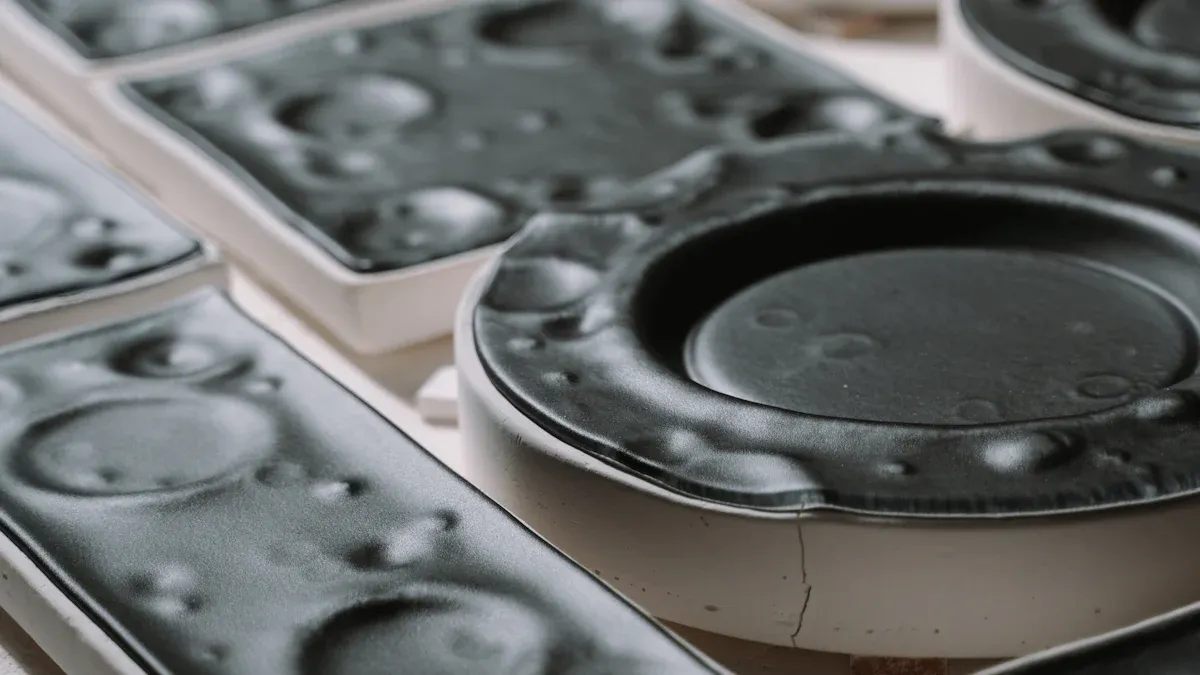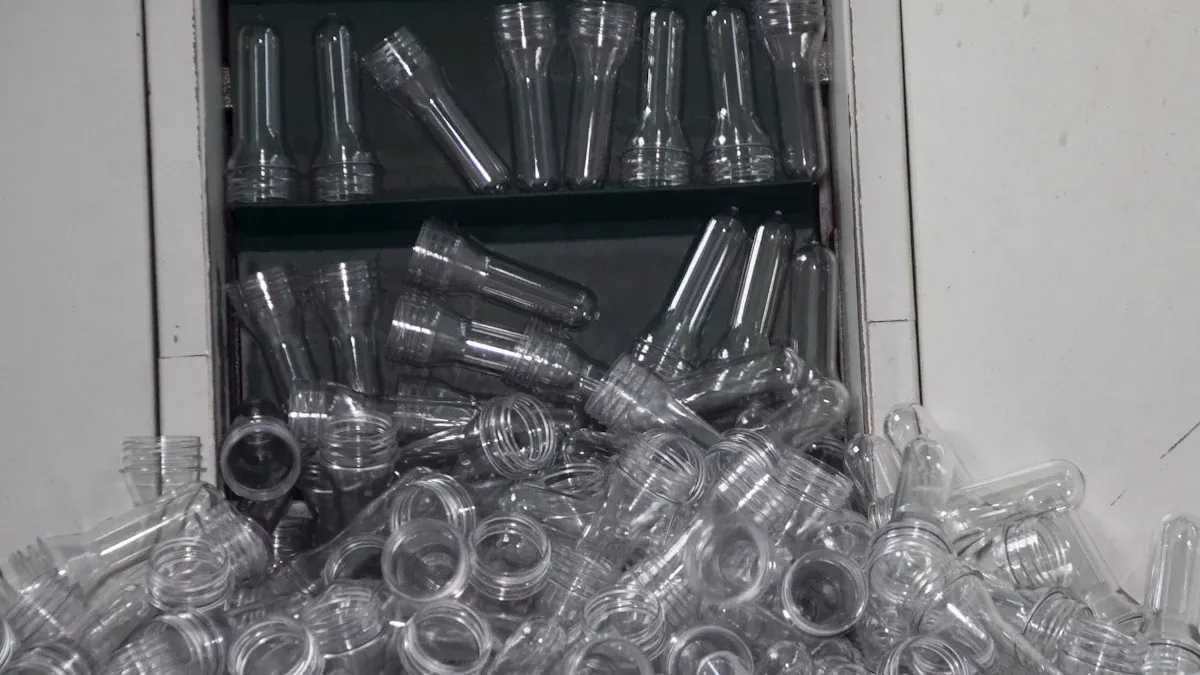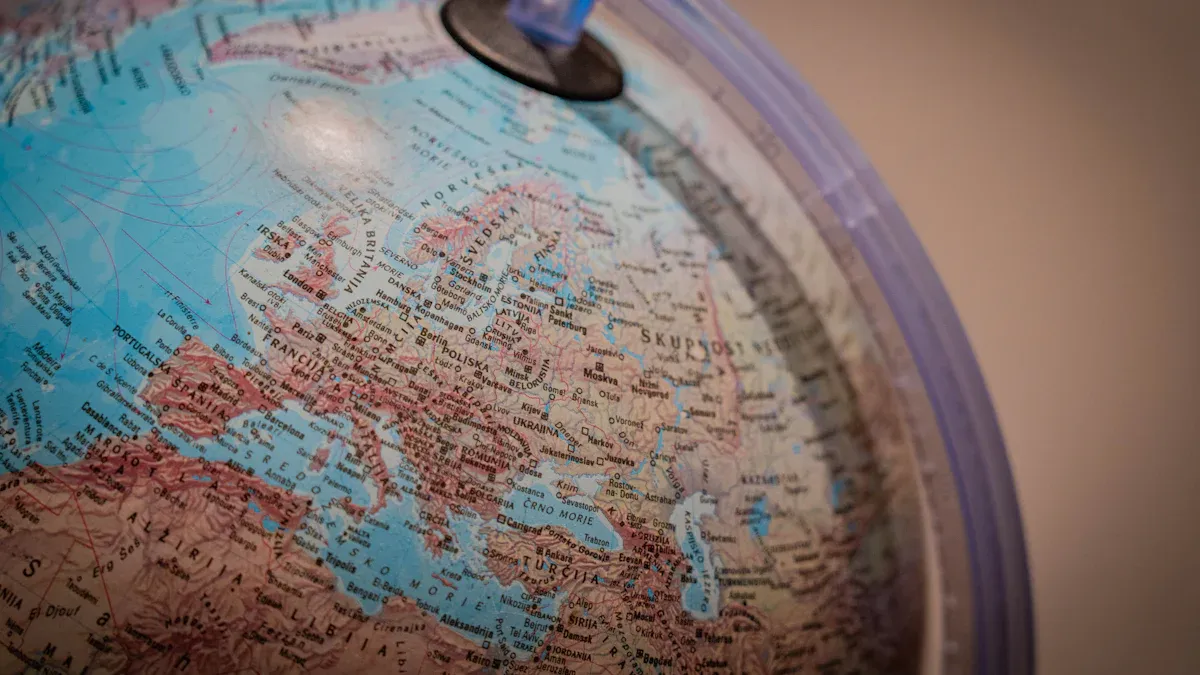
Injection molding costs vary significantly between Asia and Europe. Labor expenses in Asia are generally lower, which reduces overall production costs. Europe, however, often provides higher-quality production standards. Material availability also differs by region, with Asia offering cost-effective options and Europe focusing on premium-grade resources. Shipping adds another layer of complexity. Asian production may involve longer lead times, while European production often ensures faster delivery. Additionally, hidden expenses like tariffs or intellectual property risks can impact your final costs. Understanding these factors helps you make informed decisions when sourcing parts.

Labor costs play a significant role in determining injection molding costs. In Asia, countries like China, India, and Vietnam offer some of the most affordable injection molding factories. For example, Chinese factories benefit from labor expenses that are 20% to 60% lower than those in Europe or North America. Vietnam also provides similar cost advantages, making it an attractive option for businesses seeking to reduce production costs. These lower labor rates allow Asian manufacturers to produce parts at a fraction of the cost compared to their European counterparts.
In Europe, labor costs are significantly higher due to stricter labor laws, higher wages, and additional benefits for workers. While this increases production costs, it often translates to better working conditions and higher-quality output. European injection molding factories typically focus on precision and consistency, which can justify the higher expenses for businesses prioritizing quality over cost.
The skill level of the workforce directly impacts the quality and efficiency of plastic injection molds. In regions like China, the workforce is highly experienced in handling high-volume production, which helps reduce cycle times and improve production output. However, the reject rates in some Asian factories may be higher due to less stringent quality control measures. On the other hand, European manufacturers often employ highly skilled technicians who excel in precision engineering. This expertise minimizes customer returns and ensures consistent quality.
| Metric | Description |
|---|---|
| Cycle Times | Time taken for each production cycle |
| Production Output | Total units produced during a specific period |
| Reject Rates | Percentage of products that did not meet quality |
| Customer Returns | Number of products returned by customers |
| Mold Changeover Times | Time taken to switch molds between production runs |
When choosing between regions, you should consider how workforce skill levels align with your priorities. If you need high-quality parts with minimal defects, European factories may be the better choice. For businesses focused on high-volume production at lower costs, Asian factories offer a competitive edge.
Labor costs influence every stage of the injection molding process, from setup to final production. In Asia, lower operator costs and reduced setup expenses make it easier to achieve cost-effective injection molding. For instance, Chinese factories can allocate more resources to high-volume production without significantly increasing costs. This is particularly beneficial for businesses looking to produce large quantities of parts at affordable rates.
| Factor | Description |
|---|---|
| Setup Costs | Time and expertise required for machine setup and tooling configurations, impacting labor expenses. |
| Repair Costs | Expenses incurred for maintaining and repairing equipment due to wear and breakdowns. |
| Operator Costs | Costs associated with monitoring automated processes, essential for efficient operation of machines. |
In Europe, higher labor costs increase production costs, but they also ensure better maintenance and monitoring of equipment. This results in fewer breakdowns and higher reliability. While Asian factories excel in affordability, European manufacturers often provide better long-term value for businesses prioritizing durability and consistency.
The availability of materials plays a crucial role in determining injection molding costs. Asia and Europe differ significantly in this aspect. In Asia-Pacific, rapid industrialization and urbanization have created a high demand for durable and cost-effective materials. Countries like China dominate the market by offering a wide range of raw materials at competitive prices. This abundance makes it easier for injection molding factories to source materials locally, reducing costs for businesses.
In Europe, the focus shifts toward sustainable material solutions. Government initiatives and growing consumer awareness drive the adoption of recycled and bio-based materials. These eco-friendly options align with circular economy principles, but they often come at a higher price. While Europe accounted for 23.7% of the global injection molding market revenue in 2022, Asia-Pacific is expected to lead by 2030, with projected revenues reaching USD 170,490.2 million. This growth highlights Asia's dominance in material availability and affordability.
The quality and pricing of plastic injection molds vary between regions. In Asia, manufacturers prioritize affordability. This approach often results in lower pricing for molds, making it an attractive option for businesses aiming to reduce production costs. However, the quality of these molds can vary. Some factories in China excel in producing high-quality molds, but others may compromise on durability to keep costs low.
Europe, on the other hand, emphasizes precision and reliability. European manufacturers invest heavily in advanced technologies and skilled labor to produce molds that meet strict quality standards. These molds often last longer and require less maintenance, which can save you money in the long run. While the initial pricing may be higher, the superior quality ensures consistent performance, especially for high-volume production.
| Region | Focus Area | Pricing ($) | Quality Level |
|---|---|---|---|
| Asia | Cost-effectiveness | Low | Variable |
| Europe | Precision and sustainability | High | Consistent |
When deciding between regions, consider your priorities. If you need affordable molds for short-term use, Asia offers excellent options. For long-term projects requiring high-quality molds, Europe provides better value.
Supply chain efficiency significantly impacts the overall cost and delivery of injection molding parts. Asia-Pacific benefits from a well-established supply chain network, particularly in China. The region's rapid industrial growth has streamlined material sourcing and distribution. This efficiency allows injection molding factories to maintain competitive pricing and meet tight deadlines.
Europe's supply chain focuses on resource efficiency and sustainability. Manufacturers often source materials locally to reduce environmental impact. While this approach aligns with eco-friendly practices, it can lead to higher costs and longer lead times. However, Europe's emphasis on quality control ensures that you receive reliable parts with minimal defects.
Tip: Evaluate your supply chain needs based on your project's priorities. If cost and speed are critical, Asia's supply chain offers unmatched efficiency. For eco-conscious projects, Europe's sustainable practices may align better with your goals.
Quality control plays a vital role in injection molding. In Asia, factories often focus on high-volume production, which can sometimes lead to inconsistent quality. While many manufacturers implement quality checks, the standards may vary widely. Some factories excel in delivering reliable parts, but others might compromise on precision to meet tight deadlines. This variability can affect the overall reliability of plastic injection molds.
In Europe, quality control is a top priority. Manufacturers adhere to strict protocols to ensure every part meets precise specifications. Advanced technologies, such as automated inspection systems, are commonly used to detect defects early. This attention to detail results in consistent quality, making European factories a preferred choice for industries requiring high-precision parts.
Certifications ensure that manufacturers meet industry standards. European factories often align with ISO 9001 and ISO 14001 certifications, which emphasize quality management and environmental responsibility. For example, 68% of training contracts in Europe require ISO 14001-aligned content, reflecting the region's commitment to sustainability. Central Europe also leads in DIN-standard programs, controlling 47% of certified training volume. These certifications not only enhance reliability but also justify premium pricing for European manufacturers.
In Asia, certifications like ISO 9001 are also prevalent, but their implementation can vary. While many factories meet global standards, others may not prioritize certification, especially in cost-sensitive markets. When sourcing from Asia, you should verify the certifications of potential suppliers to ensure they meet your quality expectations.
| Certification/Standard | Region | Impact on Industry |
|---|---|---|
| ISO 9001 | Global | Premium pricing (20-30% higher) for certified programs |
| ISO 14001 | Europe | 68% of training contracts require ISO 14001-aligned content |
| DIN-standard programs | Central Europe | Controls 47% of certified training volume |
Reliability and consistency are critical for cost-effective injection molding. European manufacturers excel in delivering consistent results due to their focus on precision and adherence to standards. This reliability reduces the risk of defects, saving you money on rework or replacements. Although European pricing is higher, the long-term benefits often outweigh the initial costs.
Asian manufacturers, on the other hand, offer cost advantages that make them attractive for high-volume production. However, the variability in quality can sometimes lead to higher reject rates. To mitigate this risk, you should work with reputable suppliers and establish clear quality expectations. By balancing cost and quality, you can achieve cost-effective injection molding tailored to your needs.

Shipping costs and lead times vary significantly between Asia and Europe. When sourcing injection molding parts from Asia, you may encounter higher shipping costs due to the longer distances involved. For example, shipping a 500 kg pallet from China can cost between $300 and $500. In contrast, sourcing from Europe often results in lower shipping expenses and faster delivery times because of proximity to key markets.
| Aspect | Asia Sourcing | Europe Sourcing |
|---|---|---|
| Shipping Cost (Example) | $300 - $500 for 500 kg pallet | Lower due to shorter distance |
| Delivery Time | Longer due to distance | Faster due to proximity |
Lead times also differ. Parts from China may take up to a month to arrive, especially when supply chain disruptions occur. European injection molding factories, on the other hand, can deliver parts more quickly, making them a better choice for time-sensitive projects.
Shipping delays and regulatory challenges can impact your project timeline. In Asia, seasonal factors like Chinese New Year often disrupt production schedules, leading to longer lead times. Regulatory hurdles, such as customs clearance and tariffs, add further complexity. Statistical analyses reveal that these delays are more frequent in Asia compared to Europe, where streamlined regulations and efficient logistics systems reduce such risks.
To mitigate these challenges, you should plan for potential delays when sourcing from Asia. Working with experienced logistics partners can help navigate regulatory requirements and minimize disruptions.
Logistics also have environmental implications. Asia and Europe differ in their approaches to sustainability within injection molding supply chains. European manufacturers often consolidate shipments to reduce transportation costs and carbon emissions. They also adopt energy-efficient technologies and recycling practices to minimize waste. In Asia, efforts to improve logistics efficiency are growing, but the environmental impact remains higher due to the region's reliance on long-distance shipping.
| Aspect | Evidence |
|---|---|
| Energy Efficiency | Adoption of new technologies reduces electricity consumption during production, lowering carbon emissions. |
| Waste Reduction | Use of recycling, optimized mold designs, and efficient practices minimizes waste in production and packaging. |
| Logistics Efficiency | Consolidating shipments reduces transportation costs and carbon emissions, diminishing logistics' environmental impact. |
When choosing between regions, consider how logistics align with your sustainability goals. Europe offers eco-friendly practices, while Asia provides cost advantages but with a higher environmental footprint.
Tariffs and import/export duties can significantly affect injection molding costs. These charges often vary between regions, influencing where you choose to source your parts. For example, in February 2020, China introduced waivers on tariffs for certain US plastics. This change caused a surge in trade volumes. US exports of high-density polyethylene (HDPE) to China increased over four-fold from 2019 to 2023. Linear low-density polyethylene (LLDPE) exports rose almost seven-fold during the same period. These shifts highlight how tariff adjustments can reshape trade flows and impact costs.
In Europe, domestic tariffs and competition from local brands also play a role. Trade regulations often prioritize local production, which can increase costs for imported materials. Understanding these dynamics helps you plan better and avoid unexpected expenses.
When working with manufacturers in different regions, communication barriers and cultural differences can lead to hidden costs. In Asia, language differences may cause misunderstandings during the design or production phases. Miscommunication can result in delays or the need for rework, increasing your overall expenses. Cultural norms, such as differing approaches to deadlines or quality expectations, may also affect project timelines.
European manufacturers often have fewer language barriers, especially for English-speaking clients. However, cultural differences still exist, particularly in business practices. Clear communication and detailed contracts can help you minimize these risks, regardless of the region.
Protecting intellectual property (IP) is crucial when sourcing injection molding services. In Asia, particularly in China, IP risks are a common concern. While many manufacturers follow strict guidelines, some may not prioritize IP protection. This can lead to unauthorized use of your designs or molds. Conducting thorough research and working with trusted suppliers can reduce these risks.
Europe generally offers stronger IP protections. Manufacturers often adhere to strict legal frameworks, ensuring your designs remain secure. Although costs may be higher, the added security can provide peace of mind for businesses handling sensitive projects.
Tip: Always verify a supplier's IP policies before sharing your designs. This step can save you from costly legal disputes later.
Injection molding costs differ significantly between Asia and Europe. Asia offers lower labor and material costs, making it ideal for high-volume, cost-sensitive projects. Europe, however, excels in quality, precision, and reliability, which justifies its higher pricing.
When choosing a region, consider your priorities. If affordability and speed matter most, Asia might suit your needs. For projects requiring strict quality standards or IP protection, Europe provides better value.
Tip: Evaluate trade-offs carefully. Balancing cost, quality, and delivery time ensures you make the best decision for your business.
Focus on your project’s needs. If cost and speed are critical, Asia offers affordability and efficiency. For high-quality parts or strict IP protection, Europe provides better reliability. Evaluate your priorities, such as budget, quality, and delivery time, to make the best decision.
Consolidate shipments to lower transportation expenses. Work with experienced logistics partners to optimize routes and avoid delays. Planning ahead also helps you minimize costs by avoiding peak shipping seasons, such as Chinese New Year.
Tip: Always compare shipping quotes from multiple providers to find the best deal.
Yes, European factories often prioritize sustainability. They use recycled materials, energy-efficient technologies, and eco-friendly practices. Asian factories are improving in this area, but their reliance on long-distance shipping increases their environmental footprint.
Choose reputable suppliers with proven track records. Verify certifications like ISO 9001 and request samples before committing to large orders. Clear communication about quality expectations also reduces the risk of defects.
Hidden costs include tariffs, longer lead times, and potential IP risks. Miscommunication or cultural differences may also lead to delays or rework. Researching suppliers and planning for these factors can help you avoid unexpected expenses.
Note: Always review contracts carefully to identify any additional fees or terms.